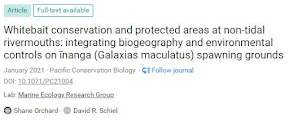Available online here https://hdl.handle.net/10092/101857
Friday 12 February 2021
Recover newsletter issue 6 on Kaikōura coastal recovery
Monday 8 February 2021
Whitebait spawning grounds at non-tidal rivermouths
We recently published a study of īnanga (Galaxias maculatus) spawning grounds at non-tidal rivermouths in Pacific Conservation Biology.
Article freely available hereNon-tidal rivermouths are common on the east coast of the South island and south-east of the North Island where they are commonly associated with high energy mixed sand-gravel beaches that form perched lagoons or hāpua at the rivermouth.
At the outset of the study the spatial pattern of spawning in these environments grounds was unknown. Some of the interesting findings were that the location of spawning was close to the rivermouth despite the lack of salt water intrusion or tidal influence, both of which are associated with spawning grounds in tidal situations.
A downstream fish migration evidently still occurs prior to spawning events and fish movements were surprisingly rapid in response to spawning cues in many instances. Spawning events are triggered by water level changes as occurs in tidal rivermouths, but appear to be more haphazard due to their origins being rain events rather than regular tidal cycles.Geographical aspects of the spawning locations were remarkably consistent across all seven study sites in key aspects such as the position in the catchment, relationship with water changes and presence of riparian vegetation.
This provides a solid basis for identifying and managing spawning habitat in other non-tidal rivers. Effects we recorded included spawning on flood events that resulted in spawning grounds being located some distance from the active channel. As with tidal situations this places the eggs at risk from human activities in those same zones, but potentially presents a more difficult management proposition due to these events being less predictable. Their irregular nature suggests they are less likely to be accommodated in riparian zone planning and management. Importantly, the spawning grounds are located close to the peak water levels experienced on these events, which coincides with areas that are only briefly inundated.
Recognising and protecting these emphemeral flood-zone areas is the key to effective conservation.
Read the full article here




